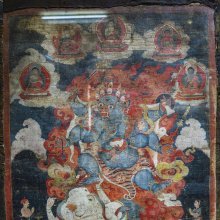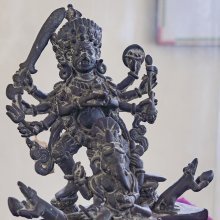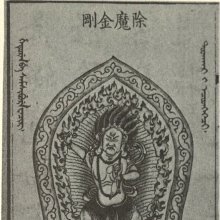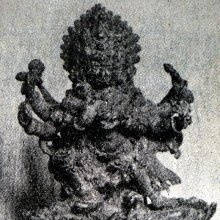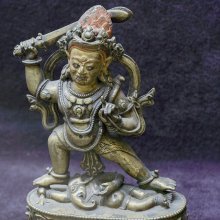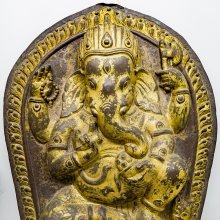Vighnantaka, Vighnāntaka, Vighna-antaka: 7 definitions
Introduction:
Vighnantaka means something in Buddhism, Pali, Hinduism, Sanskrit. If you want to know the exact meaning, history, etymology or English translation of this term then check out the descriptions on this page. Add your comment or reference to a book if you want to contribute to this summary article.
Images (photo gallery)
(+2 more images available)
In Hinduism
Shaktism (Shakta philosophy)
Source: Google Books: ManthanabhairavatantramVighnāntaka (विघ्नान्तक) refers to one of the eight Heroes (vīra-aṣṭaka) associated with Jālandhara (which is in the southern quarter), according to the Manthānabhairavatantra, a vast sprawling work that belongs to a corpus of Tantric texts concerned with the worship of the goddess Kubjikā.—[...] The eight heroes: Ananta, Jvāla, Jṛmbhaṇa, Stambhana, Mohana, Stambhakārī, Saṃkarṣaṇa, Vighnāntaka.

Shakta (शाक्त, śākta) or Shaktism (śāktism) represents a tradition of Hinduism where the Goddess (Devi) is revered and worshipped. Shakta literature includes a range of scriptures, including various Agamas and Tantras, although its roots may be traced back to the Vedas.
In Buddhism
Tibetan Buddhism (Vajrayana or tantric Buddhism)
Source: archive.org: The Indian Buddhist Iconography1) Vighnāntaka (विघ्नान्तक) refers to one of the various emanations of Akṣobhya having their Sādhana described in the 5th-century Sādhanamālā (a collection of sādhana texts that contain detailed instructions for rituals).—His colour is blue; his Āsana is the pratyālīḍha; his Symbols are the tarjanīpāśa and vajra.—Vighnāntaka is closely associated with three other gods, Padmāntaka, Yamāntaka, and Prajñāntaka, who are generally represented as guardians of the gates in the Maṇḍala. Vighnāntaka is represented in various forms. The name is significant as the word “vighna” or “obstacle” refers to the Hindu god Gaṇeśa.
The Dhyāna (meditation instructions) of Vighnāntaka described in the Sādhanamālā as follows:—
“The worshipper should conceive himself as (Vighnāntaka) who stands in the pratyālīḍha attitude, is one-faced, two-armed, and blue in colour. He carries in his left hand the tarjanīpāśa, and wields the vajra in the right. He is terrible in appearance and his brown hair rises upwards. His seat is on the orb of the sun placed on a lotus”.
[This sādhana is silent about the prostrate figure of Gaṇeśa whom he tramples under his feet, thereby giving significance to his name as already indicated. It may be pointed out here that the god Gaṇeśa, whom the Hindus consider to be the remover of all obstacles, is regarded as the most dangerous obstacle by the Buddhists! As to the origin of this god there runs a Nepalese legend that at a certain time an Oḍiyāna Pandit was performing a Tāntric rite on the bank of the Baghmati river near Kathmandu in order to obtain siddhi (perfection). Gaṇeśa, it is said, being strongly opposed to the idea, began throwing dangerous obstacles in the way of the due performance of the rite. The Oḍiyāna Pandit finding himself helpless, invoked the god Vighnāntaka, the destroyer of all obstacles, and lo ! Vighnāntaka appeared in a fierce and terrible form, armed with destructive weapons and gave hot chase to Gaṇeśa, who was by this time, flying in terror, and in no time overcame the latter.]
2) Vighnāntaka (विघ्नान्तक) presides over the north and represents one of the ten deities of the quarters (Dikpāla) commonly depicted in Buddhist Iconography, and mentioned in the 11th-century Niṣpannayogāvalī of Mahāpaṇḍita Abhayākara.—His Colour is green; he has three faces and six arms.—The fourth deity in the series is Vighnāntaka who is already well-known [...]. Vighnāntaka as the lord of the North.
Vighnāntaka is described in the Niṣpannayogāvalī (mañjuvajra-maṇḍala) as follows:—
Source: academia.edu: The Structure and Meanings of the Heruka Maṇḍala“Vighnāntaka is in the North and is green in colour. His three faces show green, white and red colour. He holds the fearful vajra, the sword, the jewel and the lotus”
[The principal hands embrace the śakti as usual. In the vajrahūṃkāra-maṇḍala his second name is Analārka.]
Vighnāntaka (विघ्नान्तक) is the name of a Vīra (hero) who, together with the Ḍākinī named Vighnāntakī forms one of the 36 pairs situated in the Hṛdayacakra, according to the 10th century Ḍākārṇava chapter 15. Accordingly, the hṛdayacakra refers to one of the four divisions of the sahaja-puṭa (‘innate layer’), situated within the padma (lotus) in the middle of the Herukamaṇḍala. The 36 pairs of Ḍākinīs and Vīras [viz., Vighnāntaka] are reddish yellow in color; they each have one face and four arms; they hold a skull bowl, a skull staff, a small drum, and a knife.

Tibetan Buddhism includes schools such as Nyingma, Kadampa, Kagyu and Gelug. Their primary canon of literature is divided in two broad categories: The Kangyur, which consists of Buddha’s words, and the Tengyur, which includes commentaries from various sources. Esotericism and tantra techniques (vajrayāna) are collected indepently.
General definition (in Buddhism)
Source: Wisdom Library: Dharma-samgrahaVighnāntaka (विघ्नान्तक) refers to the fourth of the “ten wrathful ones” (daśakrodha) as defined in the Dharma-saṃgraha (section 11). The Dharma-samgraha (Dharmasangraha) is an extensive glossary of Buddhist technical terms in Sanskrit (e.g., daśa-krodha and Vighnāntaka). The work is attributed to Nagarguna who lived around the 2nd century A.D.
Languages of India and abroad
Sanskrit dictionary
Source: Cologne Digital Sanskrit Dictionaries: Edgerton Buddhist Hybrid Sanskrit DictionaryVighnāntaka (विघ्नान्तक).—name of one of the 10 krodha: Dharmasaṃgraha 11; Sādhanamālā 137.9 etc. See next.
Source: Cologne Digital Sanskrit Dictionaries: Monier-Williams Sanskrit-English DictionaryVighnāntaka (विघ्नान्तक):—[=vi-ghnāntaka] [from vi-ghna > vi-ghana] m. = ghna-nāśaka, [Kathāsaritsāgara]
[Sanskrit to German]
Sanskrit, also spelled संस्कृतम् (saṃskṛtam), is an ancient language of India commonly seen as the grandmother of the Indo-European language family (even English!). Closely allied with Prakrit and Pali, Sanskrit is more exhaustive in both grammar and terms and has the most extensive collection of literature in the world, greatly surpassing its sister-languages Greek and Latin.
See also (Relevant definitions)
Partial matches: Vighna, Antaka.
Query error!
Full-text: Analarka, Stambhana, Mohana, Samkarshana, Ten Wrathful Ones, Stambhakari, Dashakrodha, Jvala, Jrimbhana, Hridayacakra, Ananta.
Relevant text
Search found 3 books and stories containing Vighnantaka, Vighnāntaka, Vighna-antaka; (plurals include: Vighnantakas, Vighnāntakas, antakas). You can also click to the full overview containing English textual excerpts. Below are direct links for the most relevant articles:
The Indian Buddhist Iconography (by Benoytosh Bhattachacharyya)
Shaiva Tantra: A way of Self-awareness (by L. N. Sharma)
A Dictionary Of Chinese Buddhist Terms (by William Edward Soothill)
Related products
